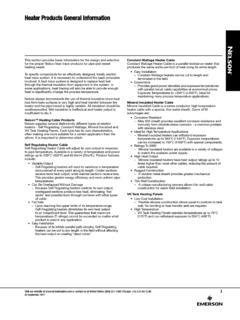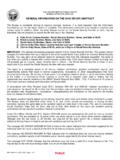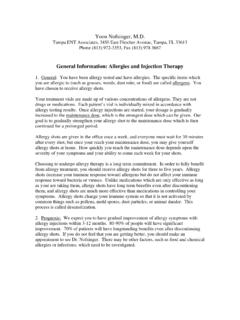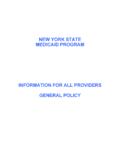Transcription of ADI General RoHS Compliance Information - …
1 ADI General RoHS Compliance Information Page 1 of 6 1. RoHS compliant definition ADI defines RoHS compliant to mean Pb, Hg, Cd, Cr(+6), PBB, and PBDE are not intentionally added during the manufacturing process and have upper concentration limits as defined below. In addition, RoHS compliant indicates the packages can withstand a peak reflow temperature of 255 +5/-0 deg C. RoHS Banned Substance CAS Number Maximum Concentration Value Hg (Mercury) 7439-92-1 1000 ppm Pb (Lead) 7439-97-6 1000 ppm Cd (Cadmium) 7440-43-9 100 ppm Cr(+6) (Hexavalent Chromium) 18540-29-9 1000 ppm PBB (Polybrominated Biphenyl) - 1000 ppm PBDE (Polybrominated Diethyl Ether) - 1000 ppm DEHP (Bis(2-Ethylhexyl) phthalate ) - 1000 ppm BBP (Benzyl butyl phthalate) - 1000 ppm DBP (Dibutyl phthalate) - 1000 ppm DIBP (Diisobutyl phthalate) - 1000 ppm 2. RoHS compliant package materials and terminal finishes ADI offers RoHS compliant solutions for most of its products.
2 Material sets have been qualified to withstand a +255 C (+5/-0 C) peak reflow temperature. The primary terminal finishes for plastic encapsulated and hermetic products are matte Sn plating with a post plating bake (1 hour at 150 C within 24 hours of plating, implemented between EIA date code 0518-0522), SnAgCu solder spheres, and Au plating. NiPdAu is also available for select products. 3. Part naming convention for RoHS Compliance The standard naming convention for RoHS compliant products requires the letter "Z" as a suffix to the existing part number. The Z suffix generally appears at the end of the part name ( after the character that denotes the package style). For example: Standard Part Name RoHS Compliant Part Name ADM1024 ARU-REEL ADM1024 ARUZ-REEL AD648KR AD648 KRZ AD7528KP-REEL7 AD7528 KPZ-REEL7 Certain products introduced to the market as RoHS compliant only ( there is no standard SnPb or SnPbAg finish on these parts) do not carry a "Z" suffix, but the data sheet, web product page, part marking, and labeling clearly indicate these products as RoHS compliant.
3 All models intended to be offered as RoHS compliant are visible to customers through the WWW ordering guide. Customers should contact Local Sales or Distributors with any new product transition requests. ADI General RoHS Compliance Information Page 2 of 6 4. Part marking convention for RoHS Compliance RoHS compliant devices have a "#" symbol marked on the top or bottom of the package. Smaller packages, such as SOT23, SC70 and TSOT, are too small to accommodate an additional character, and as a result, there is no "#" marking on the package. For these smaller packages, a unique brand code is used to denote RoHS Compliance . 5. Labeling for RoHS Compliance Shipping containers for products compliant with RoHS regulations are labeled with RoHS Compliant and China environment-friendly logos. The labels also contain the Pb free external finish code ( , e3, e1, etc) as specified in JEDEC JESD97 standard and MSL ratings.
4 Shipping Label LOGOS RoHS China Environment-Friendly Use Period or EFUP * RoHS Compliant RoHS Exempt Example RoHS Non-Compliant * EFUP = environment-friendly-use-period, 50 years for components and 25 years for components containing a PCB ADI General RoHS Compliance Information Page 3 of 6 6. RoHS Compliance transition history ADI transitioned products to RoHS Compliance under PCN #02_0011 and #04_0065. PCN #02_0011 (closed 2004): LFCSP, LQFP, MQFP, miniSO, PDIP, QSOP, SOIC, SOT-23, SSOP, TQFP, TSSOP PCN #04_0065 (closed 2007): CSP_BGA, Header, LQFP 24x24, LQFP integrated heat sink, MQFP 32x32, MQFP integrated heat sink, PBGA, PLCC, PSOP, QSOP exposed pad, SBDIP, SBGA, SC70, SOIC exposed pad, SOT-143, SOT-223, TO-92, TQFP exposed pad, TSSOP exposed pad, TSOT, WLCSP 7. Support for materials with Pb ADI encourages customers to transition to RoHS compliant products but will continue to support SnPb plating and SnPbAg solder spheres where manufacturing capability exists at our supplier base.
5 ADI has no plan to make cerdip or cerpack packages RoHS compliant. ADI continues to use Pb in die attach adhesives, glass, and flip chip interconnection where regulations allow an exemption until reliable alternatives are available. ADI defines RoHS Compliant with Exemption or RoHS Exempt as products that contain lead but are compliant with the EU Directive 2011/65/EU also known as RoHS Directive that applies to a specific EU RoHS Exemption. Under Article 4 of the following conditions applies to the following exemption LFCSP-Sawn and PSOP packages labeled as RoHS with Exemption are assembled using Die attach material containing more than 90%Pb. These fall under Exemption 7(a) Lead in high melting temperature type solders ( lead-based alloys containing 85 % by weight or more lead). MEMS products in SOIC, LFCSP, LGA Packages labeled as RoHS with Exemption uses solder seal that falls under Exemption 7(c)-1, Electrical and electronic components containing lead in a glass or ceramic other than dielectric ceramic in capacitors, piezoelectronic devices, or in a glass or ceramic matrix compound , SOT23 FCOL, TSOT23 FCOL, Flip chip BGA labeled as RoHS with Exemption use lead contained solder bumps that fall under falls under Exemption 15 Lead in solders to complete a viable electrical connection between semiconductor die and carrier within integrated circuit flip chip packages 8.
6 Reflow profile ADI advises reflow profiles should conform to JEDEC J-STD-020 standard which can be downloaded from the JEDEC website under Free Standards . ADI General RoHS Compliance Information Page 4 of 6 9. Backward and forward compatibility Backward compatibility for matte Sn, NiPdAu and Au: ADI products with matte Sn, NiPdAu, and Au finishes are backward compatible with optimized SnPb reflow processes. Backward compatibility for SnAgCu: ADI products with SnAgCu solder finishes are not backward compatible with SnPb reflow processes. Forward compatibility for SnPb: ADI products with SnPb finish are not forward compatible with +255 C (+5/-0 C) reflow processes. Concerns include weak solder joints caused by Bi in the solder paste reacting with Pb delamination resulting from package material sets that are not +255 C (+5/-0 C) compatible, and solder ball voiding caused by Pb free solder paste outgassing into the solder ball.
7 10. Matte Sn whisker data Matte Sn is a widely available industry standard that has been in production for many years with excellent quality and reliability. All matte Sn plated devices undergo a post plating bake for 1 hour at 150 degrees C within 24 hours of plating to mitigate Sn whisker growth. Sn whisker testing is done based on the test methodology outlined in JEDEC JESD22A121 standard (Test Method for Measuring Whisker Growth on Tin and Tin Alloy Surface Finishes) with read-point intervals of 1000 hours or 500 cycles. Test results are in the table below. Criteria Maximum 20 um (Class 1a) Maximum 40 um (Class 2) Maximum 45 um (Class 2) Package Preconditioning Temperature Humidity Storage (30/60%RH, 4000 Hrs) High Temperature Humidity Storage (55'C/85%RH, 4000 Hrs) Temperature Cycle (-55/+85'C,1500 Cyc) LFCSP No precon Acceptable Acceptable Acceptable Precon @ 215-220'C Acceptable Acceptable Acceptable Precon @ 260'C Acceptable Acceptable Acceptable LQFP No precon Acceptable Acceptable Acceptable Precon @ 215-220'C Acceptable Acceptable Acceptable Precon @ 260'C Acceptable Acceptable Acceptable MQFP No precon Acceptable Acceptable Acceptable Precon @ 215-220'C Acceptable Acceptable Acceptable Precon @ 260'C Acceptable Acceptable Acceptable MINISO No precon See QSOP results See QSOP results See QSOP results Precon @ 215-220'C See QSOP results See QSOP results See QSOP results Precon @ 260'C Acceptable Acceptable Acceptable PDIP No precon Acceptable Acceptable Acceptable Precon @ 215-220'C Acceptable Acceptable Acceptable Precon @ 260'C Acceptable Acceptable Acceptable PLCC No precon Acceptable Acceptable Acceptable Precon @ 215-220'C Acceptable Acceptable Acceptable Precon @ 260'C
8 Acceptable Acceptable Acceptable PSOP No precon Acceptable Acceptable Acceptable Precon @ 215-220'C Acceptable Acceptable Acceptable Precon @ 260'C Acceptable Acceptable Acceptable QSOP No precon Acceptable Acceptable Acceptable ADI General RoHS Compliance Information Page 5 of 6 Criteria Maximum 20 um (Class 1a) Maximum 40 um (Class 2) Maximum 45 um (Class 2) Package Preconditioning Temperature Humidity Storage (30/60%RH, 4000 Hrs) High Temperature Humidity Storage (55'C/85%RH, 4000 Hrs) Temperature Cycle (-55/+85'C,1500 Cyc) Precon @ 215-220'C Acceptable Acceptable Acceptable Precon @ 260'C Acceptable Acceptable Acceptable SC70/ SOT143/ SOT23-3Ld No precon Acceptable Acceptable Acceptable Precon @ 215-220'C Acceptable Acceptable Acceptable Precon @ 260'C Acceptable Acceptable Acceptable SOIC_N No precon Acceptable Acceptable Acceptable Precon @ 215-220'C Acceptable Acceptable Acceptable Precon @ 260'C Acceptable Acceptable Acceptable SOIC_W No precon Acceptable Acceptable Acceptable Precon @ 215-220'C Acceptable Acceptable Acceptable Precon @ 260'C Acceptable Acceptable Acceptable SOT223 No precon Acceptable Acceptable Acceptable Precon @ 215-220'C Acceptable Acceptable Acceptable Precon @ 260'C Acceptable Acceptable Acceptable SOT23 No precon See QSOP results See QSOP results See QSOP results Precon @ 215-220'C See QSOP results See QSOP results See QSOP results Precon @ 260'C Acceptable Acceptable
9 Acceptable SSOP No precon Acceptable Acceptable Acceptable Precon @ 215-220'C Acceptable Acceptable Acceptable Precon @ 260'C Acceptable Acceptable Acceptable TQFP No precon Acceptable Acceptable Acceptable Precon @ 215-220'C Acceptable Acceptable Acceptable Precon @ 260'C Acceptable Acceptable Acceptable TSSOP No precon Acceptable Acceptable Acceptable Precon @ 215-220'C Acceptable Acceptable Acceptable Precon @ 260'C Acceptable Acceptable Acceptable 11. Pentabromodiphenylether and octabromodiphenylether ADI products do not contain pentabromodiphenylether and octabromodiphenylether. 12. Bromine and chlorine free material sets ADI is going beyond RoHS Compliance to improve product recyclability by converting to bromine (Br) free and chlorine (Cl) free material sets. Bromine free and chlorine free is also referred to in the industry as halogen free or low halogen. ADI defines halogen free within a homogeneous material to mean the maximum concentration of Br is 900 ppm, the maximum concentration of Cl is 900 ppm, and the maximum concentration of total Br + Cl is 1500 ppm.
10 All new products are released with halogen free material sets. Customers are notified by PCN for products undergoing conversion to halogen free material sets. ADI is close to completing the transition for lead-framed packages. Nearly all laminate based products are assembled with ADI General RoHS Compliance Information Page 6 of 6 halogen free die attach adhesives and mold compounds, but older laminate designs might contain bromine and chlorine. 13. RoHS Compliance for Evaluation Boards Analog Devices evaluation boards are specifically designed for the purpose of research and development and are made available solely on a business-to-business basis and are therefore excluded from the scope of the RoHS 2 Directive.
















